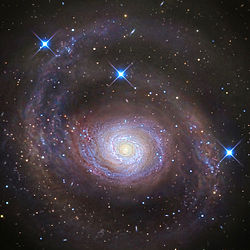Messier 94
 |
|
| M94 Galaxy | |
| Observation data Epoch J2000 |
|
|---|---|
| Constellation | Canes Venatici |
| Right ascension | 12h 50m 53.1s |
| Declination | +41° 07′ 14″ |
| Apparent dimension (V) | 11.2 × 9.1 moa |
| Apparent magnitude (V) | 8.99 |
| Characteristics | |
| Type | (R)SA(r)ab,LINER |
| Astrometry | |
| Heliocentric radial velocity | 308 ± 1km/s |
| Redshift | 0.001027 ± 0.000005 |
| Galactocentric velocity | 360 ± 3km/s |
| Distance | 16.0 ± 1.3 Mly (4.91 ± 0.40 Mpc) |
| Other designations | |
Messier 94 (also known as NGC 4736) is a spiral galaxy in the constellation Canes Venatici. It was discovered by Pierre Méchain in 1781, and catalogued by Charles Messier two days later. Although some references describe M94 as a barred spiral galaxy, the "bar" structure appears to be more oval-shaped. The galaxy has two ring structures.
M94 is classified as having a low ionization nuclear emission region (LINER) nucleus. LINERs in general are characterized by optical spectra that reveal that ionized gas is present but the gas is only weakly ionized (i.e. the atoms are missing relatively few electrons).
M94 contains both an inner ring with a diameter of 70 arcseconds and an outer ring with a diameter of 600 arcseconds. These rings appear to form at resonance locations within the disk of the galaxy. The inner ring is the site of strong star formation activity and is sometimes referred to as a starburst ring. This star formation is fueled by gas that is dynamically driven into the ring by the inner oval-shaped bar-like structure.
A 2009 study conducted by an international team of astrophysicists revealed that the outer ring of M94 is not a closed stellar ring, as historically attributed in the literature, but a complex structure of spiral arms when viewed in mid-IR and UV. The study found that the outer disk of this galaxy is active. It contains approximately 23% of the galaxy's total stellar mass and contributes about 10% of the galaxy's new stars. In fact, the star formation rate of the outer disk is approximately two times greater than the inner disk because it is more efficient per unit of stellar mass.
There are several possible external events that could have led to the origin of M94's outer disk including the accretion of a satellite galaxy or the gravitational interaction with a nearby star system. However, further research found problems with each of these scenarios. Therefore, the report concludes that the inner disk of M94 is an oval distortion which led to the creation of this galaxy's peripheral disk.
...
Wikipedia
